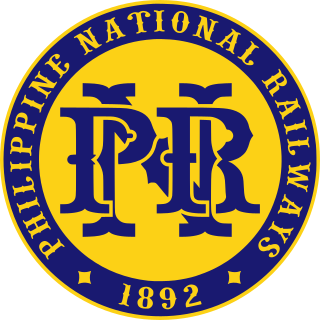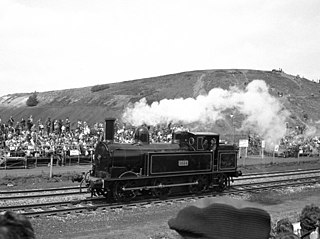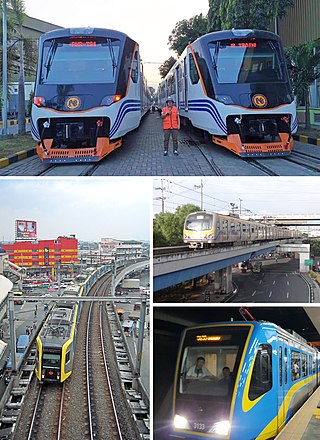
The Philippine National Railways (PNR) is a state-owned railway company in the Philippines which operates one commuter rail service between Metro Manila and Laguna, and local services between Sipocot, Naga and Legazpi in the Bicol Region. It is an attached agency of the Department of Transportation.

Under the Whyte notation for the classification of steam locomotives, 0-4-0 represents one of the simplest possible types, that with two axles and four coupled wheels, all of which are driven. The wheels on the earliest four-coupled locomotives were connected by a single gear wheel, but from 1825 the wheels were usually connected with coupling rods to form a single driven set.

0-6-0 is the Whyte notation designation for steam locomotives with a wheel arrangement of no leading wheels, six powered and coupled driving wheels on three axles, and no trailing wheels. Historically, this was the most common wheel arrangement used on both tender and tank locomotives in versions with both inside and outside cylinders.
Under the Whyte notation for the classification of steam locomotives, 2-10-2 represents the wheel arrangement of two leading wheels, ten powered and coupled driving wheels, and two trailing wheels. In the United States and elsewhere the 2-10-2 is known as the Santa Fe type, after the Atchison, Topeka and Santa Fe Railway that first used the type in 1903.

Under the Whyte notation for the classification of steam locomotives, 0-6-2 represents the wheel arrangement of no leading wheels, six powered and coupled driving wheels on three axles and two trailing wheels on one axle.

Rail transportation in the Philippines is currently used mostly to transport passengers within Metro Manila and provinces of Laguna and Quezon, as well as a commuter service in the Bicol Region. Freight transport services once operated in the country, but these services were halted. However, there are plans to restore old freight services and build new lines. From a peak of 1,100 kilometers (680 mi), the country currently has a railway footprint of 533.14 kilometers (331.28 mi), of which only 129.85 kilometers (80.69 mi) are operational as of 2023, including all the urban rail lines. World War II, natural calamities, underspending, and neglect have all contributed to the decline of the Philippine railway network. In the 2019 Global Competitiveness Report, the Philippines has the lowest efficiency score among other Asian countries in terms of efficiency of train services, receiving a score of 2.4, and ranking 86th out of 101 countries globally. The government is currently expanding the railway network up to 1,900 kilometers (1,200 mi) by 2022 through numerous projects.

Tutuban station is the central railway terminus of the Philippine National Railways (PNR) network located in the city of Manila, Philippines.

The NZR DSA class locomotive was a type of 0-6-0DM diesel-mechanical locomotives built by three different manufacturers: W. G. Bagnall, Hunslet, Mitsubishi Heavy Industries, and Vulcan Foundry for the Drewry Car Co. They were built between 1953 and 1967.

The PNR 900 class is a class of 21 GE Universal Series diesel–electric locomotives operated by the Philippine National Railways since 1973. The locomotives comes with three different types: U14CP (1973), U14C (1979), and U15C (1991). Initially used for long-distance express services throughout Luzon, they were relegated to hauling commuter trains within Metro Manila, a task previously done by PNR's diesel multiple units fleet. This was further exacerbated by the closure of the PNR South Main Line's intercity section in 2012 after an accident in Sariaya, Quezon.

The tranvía was a streetcar system that served Manila and its surrounding cities during the early years of the 20th century.
The Manila Railroad 300 class of 1914 were cog locomotives used for the Antipolo line and the Aringay–Baguio branch of the PNR North Main Line. These were also known in the railroad's mechanical department as the R class.

The Manila Railroad 45 class of 1919 were twenty-one 4-6-0 Ten-wheeler steam locomotives. Twenty locomotives were built by American light duty locomotive manufacturer H.K. Porter, Inc. between 1919 and 1921 for the Manila Railroad Company (MRR). The so-called Porters were the most successful steam locomotive class in Philippine service. They carried express trains for passengers as well as short-range maintenance trains for 70 years and served both the MRR and its successor, the Philippine National Railways. However, like all tender engines from the Manila Railroad era, the last locomotive was scrapped in the 1990s without a single unit preserved.

The Manila Railroad 200 class were 2-10-2 Santa Fe steam locomotives operated by the Manila Railroad Company (MRR), predecessor of the Philippine National Railways. They were built alongside the 4-8-2 Mountain-type 170 class by the American Locomotive Company at its Brooks facility between 1921 and 1922. During its service at the MRR, it carried heavy freight trains on the South Main Line between Manila and the Bicol Region.

The Manila Railway Dagupan class comprised thirty side tank locomotives. They were built for the Manila Railway Company between 1888 and 1890, and were the first true mainline locomotives in service of the Ferrocarril de Manila a Dagupan inter-city rail line, succeeding two of five Manila-class light-duty locomotives. One of these locomotives, No. 17 Urdaneta, survives today on static display in an open-air museum in Dagupan, Pangasinan.

The Manila Railway 100 class of 1906 was a class of five 4-4-2 Atlantic type steam locomotives built by the North British Locomotive Company for the Manila Railway Company, a predecessor of the Philippine National Railways. They were the flagship locomotives of the Manila Railway from the late 1900s to the 1910s and were the first class of tender locomotives to operate in the Philippines. They hauled the Baguio Special, an express service between Manila and Baguio via Damortis station in Rosario, La Union.

The PNR North Main Line is one of the two trunk lines of the Philippine National Railways in the island of Luzon, the other being the PNR South Main Line. The line during its maximum extent led to various cities and municipalities in Central Luzon and the Ilocos Region.

Rail transportation in the Greater Manila Area is a major part of the transportation system in Metro Manila and its surrounding areas. It consists of the Manila Light Rail Transit System, Manila Metro Rail Transit System, and the PNR Metro Commuter Line. The network makes up the majority of active railways in the country and bear the brunt of providing the metropolis with rail as a faster alternative mode of transport other than buses and jeepneys. However, these systems are currently insufficient for the rapidly expanding metropolis; to address this, new lines and line extensions are under construction, which will extend the system far out into neighboring regions.

The Manila Railway 70 class of 1908 was a class of at least twenty-two 0-6-2 side and well-tank locomotives built by the North British Locomotive Company. These locomotives were first put into service on a mainline during the late 1900s and early 1910s by the Manila Railway Company. Their primary purpose was to support the growing network and replace the aging Dagupan class engines. They were used on all the lines of the Manila Railway and its succeeding incarnation, the Manila Railroad. Over time, some locomotives were either scrapped or given to sugarcane plantations after being withdrawn. The last unit, No. 79, remained in service with the Pampanga Sugar Development Company as late as 1989.

The Manila Railroad Company (MRR) was a Filipino state-owned enterprise responsible for the management and operation of rail transport in the island of Luzon. It was originally established by an Englishman named Edmund Sykes as the private Manila Railway Co., Ltd. on June 1, 1887. British engineer Horace L. Higgins was then assigned at the helm in Manila as its first general manager. On July 7, 1906, a separate private entity named the Manila Railroad Company of New Jersey was established. The two companies continued to own the Luzon railroad network until February 4, 1916 when the Insular Government acquired both companies and absorbed them into the new Manila Railroad.

















